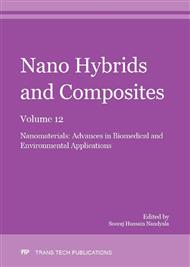[1]
R.T. Delfino, T.S. Ribeiro and J.D. Figueroa-Villar, Organophosphorus Compounds as Chemical Warfare Agents: a Review, J. Braz. Chem. Soc. 20 (2009) 407-428.
DOI: 10.1590/s0103-50532009000300003
Google Scholar
[2]
R. Sferopoulos, A Review of Chemical Warfare Agent (CWA) Detector Technologies and Commercial-Off-The-Shelf Items, Human Protection and Performance Division, DSTO, Fishermans Bend, Victoria, (2009).
Google Scholar
[3]
J. Geoghegan, J.L. Tong, Chemical warfare agents, Anaesth. Critical Care & Pain, 6 (2006) 230-234.
Google Scholar
[4]
N. Chauhan, C.S. Pundir, An amperometric biosensor based on acetylcholinesterase immobilized onto iron oxide nanoparticles/multi-walled carbon nanotubes modified gold electrode for measurement of organophosphorus insecticides, Anal. Chim. Acta. 701 (2011).
DOI: 10.1016/j.aca.2011.06.014
Google Scholar
[5]
S. Andreescu, T. Noguer, V. Magearu, J. L Marty, Screen-printed electrode based on AChE for the detection of pesticides in presence of organic solvents, Talanta. 57 (2002) 169-176.
DOI: 10.1016/s0039-9140(02)00017-6
Google Scholar
[6]
D. Du, S. Chen, J. Cai, A. Zhang, Immobilization of acetylcholinesterase on gold nanoparticles embedded in sol–gel film for amperometric detection of organophosphorous insecticide, Biosens. Bioelectron. 23 (2007) 130-134.
DOI: 10.1016/j.bios.2007.03.008
Google Scholar
[7]
A.A. Ciucu, Chemically Modified Electrodes in Biosensing, Biosens. Bioelectron. 5 (2014) 1-10.
DOI: 10.4172/2155-6210.1000154
Google Scholar
[8]
A. Sassolas, B. Prieto-Simón, J.L. Marty, Biosensors for Pesticide Detection: New Trends, J. Anal. Chem. 3 (2012) 210-232.
DOI: 10.4236/ajac.2012.33030
Google Scholar
[9]
N. Arora, Recent Advances in Biosensors Technology: A Review, Octa. J. Biosci. 1 (2013) 147-150.
Google Scholar
[10]
R. Monošík, M. Streďanský, E. Šturdík, Biosensors - classification, characterization and new trends, Acta Chimica Slovaca. 5 (2012) 109-120.
DOI: 10.2478/v10188-012-0017-z
Google Scholar
[11]
D. Du, X. Huang, J. Cai, A. Zhang, Comparison of pesticide sensitivity by electrochemical test based on acetylcholinesterase biosensor, Biosens. Bioelectron. 23 (2007) 285-289.
DOI: 10.1016/j.bios.2007.05.002
Google Scholar
[12]
G.S. Nunes, G. Jeanty, J.L. Marty, Enzyme immobilization procedures on screen-printed electrodes used for the detection of anticholinesterase pesticides Comparative study, Anal. Chim. Acta. 523 (2004) 107-115.
DOI: 10.1016/j.aca.2004.03.100
Google Scholar
[13]
S. Andreescu, L. Barthelmebs, J.L. Marty, Immobilization of acetylcholinesterase on screen-printed electrodes: comparative study between three immobilization methods and applications to the detection of organophosphorus insecticides, Anal. Chim. Acta. 464 (2002).
DOI: 10.1016/s0003-2670(02)00518-4
Google Scholar
[14]
D. Du, S. Chen, D. Song, H. Li, X. Chen, Development of acetylcholinesterase biosensor based on CdTe quantum dots/gold nanoparticles modified chitosan microspheres interface, Biosens. Bioelectron. 24 (2008) 475-479.
DOI: 10.1016/j.bios.2008.05.005
Google Scholar
[15]
Y. Li, H. J. Schluesener, S. Xu, Gold nanoparticle-based biosensor, Gold Bull. 43 (2010) 29-38.
Google Scholar
[16]
G. Cui, J.H. Yoo, J.S. Lee, J. Yoo, J.H. Uhm, G.S. Cha, H. Nam, Effect of pre-treatment on the surface and electrochemicalproperties of screen-printed carbon paste electrodes, Analyst. 126 (2001) 1399-1403.
DOI: 10.1039/b102934g
Google Scholar
[17]
T. Hezard, K. Fajerwerg, D. Evrard, V. Collière, P. Behra, P. Gros, Influence of the gold nanoparticles electrodeposition method on Hg(II) trace electrochemical detection, Electrochim. Acta. 73 (2012) 15-22.
DOI: 10.1016/j.electacta.2011.10.101
Google Scholar
[18]
T. Hezard, K. Fajerwerg, D. Evrard, V. Collière, P. Behra, P. Gros, Gold nanoparticles electrodeposited on glassy carbon using cyclic voltammetry: Application to Hg(II) trace analysis, J. Electroanal. Chem. 664 (2012) 46-52.
DOI: 10.1016/j.jelechem.2011.10.014
Google Scholar
[19]
M. Lan, C. Chen, Q. Zhou, Y. Teng, H. Zhao, X. Niu, Voltammetric detection of microcystis genus specific-sequence with disposable screen-printed electrode modified with gold nanoparticles, Adv. Mat. Lett. 3 (2010) 217-224.
DOI: 10.5185/amlett.2010.
Google Scholar
[20]
P. Fanjul-Bolado, D. Hern´andez-Santos, P.J. Lamas-Ardisana, A. Mart´ın-Pern´ıa , A. Costa-Garc´ıa, Electrochemical characterization of screen-printed and conventional carbon paste electrodes, Electrochim. Acta. 53 (2008) 3635-3642.
DOI: 10.1016/j.electacta.2007.12.044
Google Scholar
[21]
J. Wang, Study of electrodes in: Analytical Electrochemistry, second ed., Wiley-VCH, New York, 2001, pp.28-39.
Google Scholar
[22]
Y. Yang, A.M. Asiri, D. Du, Y. Lin, Acetylcholinesterase biosensor based on a gold nanoparticle–polypyrrole–reduced grapheme oxide nanocomposite modified electrode for the amperometric detection of organophosphorus pesticides, Analyst. 139 (2014).
DOI: 10.1039/c4an00068d
Google Scholar
[23]
J.A. Ho, W.L. Hsu, W.C. Liao, J.K. Chiu, M.L. Chen, H.C. Chang, C. C Li, , Ultrasensitive electrochemical detection of biotin using electrically addressable site-oriented antibody immobilization approach via aminophenyl boronic acid, Biosens. Bioelectron. 26 (2010).
DOI: 10.1016/j.bios.2010.08.048
Google Scholar
[24]
P.C. Pandey, S. Upadhyay, H.C. Pathak, C.M.D. Pandey, I. Tiwari, Acetylthiocholine/ acetylcholine and thiocholine/ choline electrochemical biosensors/sensors based on an organically modified sol–gel glass enzyme reactor and graphite paste electrode, Sens. Actuators B. 62 (2000).
DOI: 10.1016/s0925-4005(99)00367-6
Google Scholar
[25]
S. Wu, F. Huang, X. Lan, X. Wang, J. Wang, C. Meng, Electrochemically reduced graphene oxide and Nafion nanocomposite for ultralow potential detection of organophosphate pesticide, Sens. Actuators B. 177 (2013) 724-729.
DOI: 10.1016/j.snb.2012.11.069
Google Scholar
[26]
Y. Li, Y. Bai, G. Han, M. Li, Porous-reduced graphene oxide for fabricating an amperometric acetylcholinesterase biosensor, Sens. Actuators B. 185 (2013) 706-712.
DOI: 10.1016/j.snb.2013.05.061
Google Scholar


